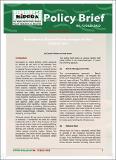Policy Brief No. 13 of 2022-2023 on Strengthening Marine Fisheries through the Blue Economy Lens
View/
Publication Date
2022Author
Type
KIPPRA Publicationsviews
downloads
Metadata
Show full item recordBy
Chelimo, Cynthia & Kaaria, Judy
Abstract/
Compared to inland fishing, which accounts for almost 80 per cent of the fisheries subsector, marine fishing is less developed. This is despite Kenya’s potential in industrial fishing based on her strategic location in the Exclusive Economic Zone (EEZ) along the most endowed tuna South-West Indian Ocean (SWIO) belt. Marine fisheries are a conventional component of the Blue Economy whose goal is to strike a balance between economic opportunities and environmental limitations to generate wealth from oceans. Besides marine fishing, Blue Economy comprises inland fishing, aquaculture, maritime law, safety and security, tourism, marine transport, shipbuilding and repair, marine cargo logistics maritime education and training, marine cargo logistics, port-related services, port agency, water sport, marine, maritime governance, ship handling, marine insurance, cargo consolidation, bunkering, offshore mining, renewable energy, bio-prospecting, blue data, marine biotechnology, transport, international shipping, among others.
Subject/
Marine Fisheries; Blue Economy Lens; Beach Management; Fishing Methods; Artisanal Fishing
Publisher
The Kenya Institute for Public Policy Research and Analysis (KIPPRA)Series
PB/13/2022-2023Collections
- Policy Briefs [165]

